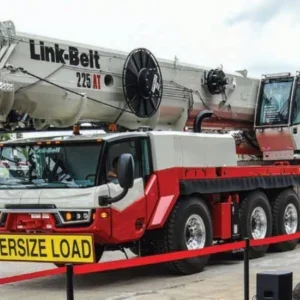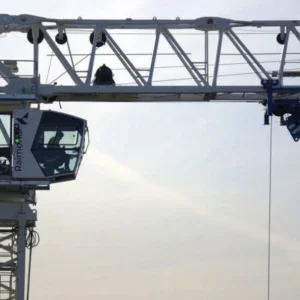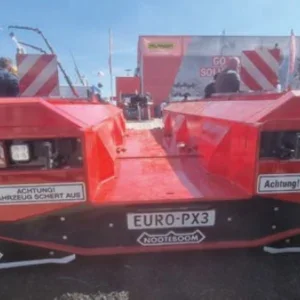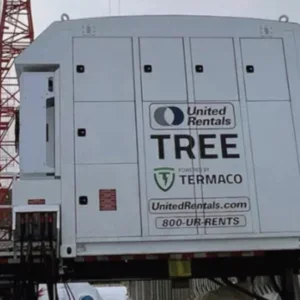Communication, both within companies and between companies and other organisations, can play a vital role in ensuring safety. At this year’s Cranes Today Crane Safety conference, at the Grange City Hotel, in London, UK, speakers explained why their organisations had realised the value of good communication, how they went about it, and the benefits they had seen.
The conference started with a presentation from Mammoet safety director Bryan Cronie. Cronie explained that, back in 2005, he had been planning on speaking at Crane Safety, that year in Amsterdam. However, on the morning he was due to fly out, he had been called away to a serious accident in Qatar, involving Mammoet’s giant strand jack-lifting system, the MSG 50.
The accident had taken place not as part of a critical lift, but during a ‘routine’ repair job. On a critical lift, the company would spend months preparing lift plans and preparing staff. On this job, this hadn’t been done.
The systems that Mammoet put into place after the accident sought to improve planning for routine repairs and rigging jobs in the yard. Cronie said, “We failed to plan what our fitter was doing.” The company came up with a new lift plan, to cover repairs such as this, within 48 hours. Under this plan, repairs and rigging would be covered in project daily meetings and toolbox talks, to ensure that the lifting procedure was communicated to the staff involved. Mammoet adopted a best practise system that saw staff informed of and involved in lift planning for these sort of jobs.
Answering a question from Alex Mullins, general manager of Al Jaber Heavy Lift, Cronie said, “We now have a procedure and paperwork system, to plan the next 24–48hrs work. Supervisors and project managers discuss the next day’s work, and identify risks. We record this meeting, and this feeds up to our full compliance meetings at 4pm each day. The findings of the compliance meeting then feed the next day’s 7am toolbox talk.”
For Mammoet, this accident had highlighted the importance of always keeping the lines of communication with staff on the ground open, regardless of the task in hand. The accident had happened, in part, because safety and planning teams hadn’t been told about the routine repair being carried, and a safety plan hadn’t been communicated to the team working on the crane.
The importance of keeping lines of communication open, or of establishing communication where it did not exist before, regardless of the job at hand, was stressed by the next speaker. In this presentation, Keith Anderson, rigging manager for Bechtel, looked beyond communication within a company, and expanded the idea to encompass communication between companies.
He said “Risk can be driven to it’s lowest practical level by: thorough, timely planning by skilled persons; review and oversight of the plan by skilled persons; and good communication of the plan.” Anderson explained that communicating the lift plan to staff wasn’t the only aspect to consider. A key area of risk lies at the interface where your job meets someone else’s. For example, on many jobs, there may be little information on the ground state, or on available lifting points. For this reason, communication with third party contractors is vital.
A third speaker addressed the importance of communication to crane safety, this time not inside or between companies, but between the industry as a whole and society at large, in the shape of cooperation between governmental regulatory bodies and industry associations. Tim Watson, safety consultant and a member of Construction Plant-hire Association’s tower crane interest group (CPA TCIG), explained that the UK Health and Safety Executive had included the CPA in discussions on British Standards relating to cranes and lifting, and had been involved with the CPA’s interest groups.
The CPA TCIG was formed in 2003. It had input with HSE into BS 7121 Part 5 –Safe use of tower cranes, the CIRIA Guide on tower crane stability and the Tower Crane Installation NVQ vocational qualification. The HSE worked with the TCIG on developing publications, on a tower crane installation training course, a guide to the safe use of self erecting tower cranes, and a series of technical information notes (TINs). The first TINs were produced in response to concerns raised by Bovis Lend Lease following an audit of 33 tower cranes in early 2005, and look at different aspects of crane safety. They are prepared by the CPA TCIG, based on HSE standards and best practice, and are scrutinised by the HSE. There are currently 22 TINs that can be downloaded free of charge from the CPA’s website, www.cpa.uk.net
HSE specialist inspectors take part in CPA special interest groups and drafting groups. Final draft guidance documents are circulated widely within HSE for comment, and there is a comment resolution between the HSE and CPA. The HSE endorses guidance documents produced by the CPA, and these are circulated to HSE inspectors by HSE. The guidance documents are published by the CPA. However, there are limits to the HSEs involvement. Most importantly, the only consider health and safety issues, not commercial matters.
Watson identified a series of benefits for the trade body and the safety organisation. For the CPA, getting HSE involvement, meant that it gives authority to CPA guidance. It allows the TCIGs to check that advice on regulations is correct. It ensures that all HSE inspectors have access to the same guidance, and ensures that guidance is practical. It allows CPA members to develop relationships with individual HSE inspectors.
For the HSE, other benefits applied; being involved with the CPA meant that it made better use of its resources, it gave it an opportunity to challenge industry’s preconceptions, to develop contacts with industry and to increase co-operation. The HSE shared in the benefit of ensuring guidance is practical and is shared among inspectors.
However, there were still areas of frustration, Watson said. The TCIG had found that many inspectors had an idealistic approach to safety. For example, in one case, an inspector had suggested using mobile access platforms for a routine, simple, repair task. The CPA members had needed to explain that such an approach would be impractical. Another problem was an inconsistent approach between different HSE regions, with different regional heads interpreting and implementing standards differently. Finally, bureaucracy and a lack of speed had slowed down the approval of guidance documents
Making talking work
Accepting the need for communication isn’t always enough though—sometimes it’s important to look at how you communicate.
As Dr Bill Robb, managing director of Safety Improvers, a behavioural psychology consultancy that works with corporate clients, explained, many of his clients asked, “What can we do to improve safety even more when our people are reasonably intelligent, we have the procedures, we do the training and we have the equipment?”
He explained that the courses he teaches use case studies and dialogue, to get people to pull up from their own knowledge an understanding of what is the safest way to act. He then explores with them why we humans often don’t do what we know we should. This leads to an understanding of what we need to do to take away those things that ‘make’ us break the rules and our own human wisdom.
Robb demonstrated this approach with a practical demonstration. The delegates (including Cranes Today’s correspondent) were split into groups, and asked to look at three accident case studies, and see what advice they would give to the people involved in the accidents. In the first two instances, these case studies were of ‘standard’ industrial incidents. The third, however, looked at a household accident.
The first two case studies prompted the delegates to think about standard best practice. For example, this correspondent’s group suggested giving advice on the importance of a tool box talk, of using the correct equipment, agreeing who is qualified to do the job, when to stop an unsafe operation and what the lines of communication on a lifting job should be. Other groups gave similar responses.
The third case study looked at a different sort of accident. In this case, an off duty worker had peeled a film lid from a pot of margarine, and leant over a toaster to throw it in the bin, setting his baggy jumper on fire. The nature of this accident prompted a different approach: the groups offered more practical (and amused) advice, such as “move the bin”, and “get a sensible jumper”.
Robb picked up on two strands from this task. Firstly, that apparently routine or ‘household’ environments encourage us to forget first principles. In fact, one in seven incidents in the oil industry, where he works most, take place in accommodation areas: at sea, these can be far more dangerous than minor accidents at home.
More importantly though, the case studies, and their responses, show that a number of important behavioural rules underlie good safety practice, and these often revolve around communication. Factors that encouraged people to forget their safety training included: a lack of awareness; natural human fears; Pressure (intentional or unintentional) from supervisors; a lack of concentration; and a lack of concern. Robb looked in details at the interaction of natural human fears and pressure from supervisors. He explained how good organisational practices, respecting staff opinions and responding to them well, could encourage good communication, and encourage staff to call a stop to operations when they saw a potential risk. Like Cronie, he emphasised the importance of always carrying out a risk assessment. He stressed that even when a job must be done, this is not an excuse for unsafe operations. Instead, the job should be looked at again, a new approach found, and a new risk assessment carried out.
Workshop leader Bill Robb with attendees Workshop leader Bill Robb with attendees Keith Anderson, Bechtel rigging manager Keith Anderson Visitors chat with exhibitors. Exhibitor Modulift was the badge sponsor. Visitors chat with exhibitors Mammoet’s Bryan Cronie Bryan Cronie UK tower crane consultant Tim Watson Tim Watson






